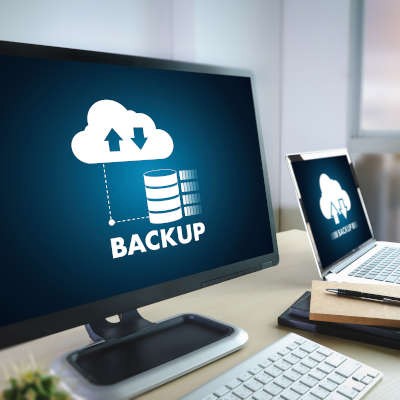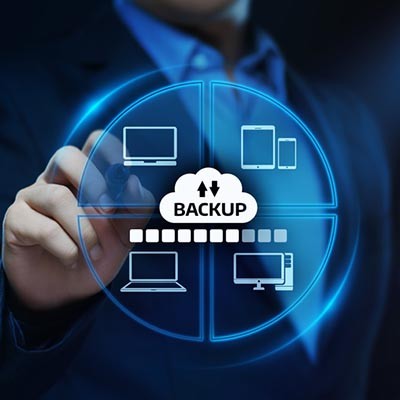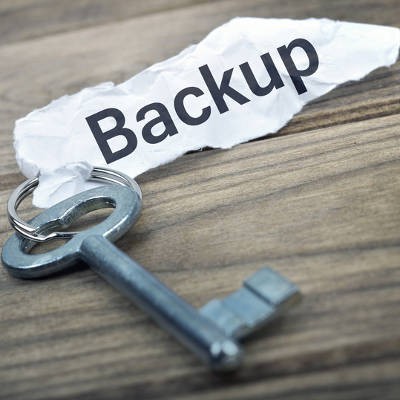Computerware Blog
Your business’ data is extremely important to the livelihood of your business and as a result, you need to have plans in place to protect it. Sure, you can invest in all the top notch cybersecurity tools and services, and they may keep you from getting your data stolen or corrupted, but what happens if something terrible happens to the servers that it is stored on? No level of threat detection is going to save a server if it is charred, under water, or its components are completely fried.
When considering a continuity plan for your business, you need to consider some scenarios that may not ever happen. This is called risk management and it is the basis of keeping your business up and running regardless of the situations that it encounters. This month, we thought we would outline some of the variables that need to be addressed when creating a comprehensive business continuity plan.
Imagine for a minute that you work in a small factory or machine shop. Some wind comes through and drops a 200-year-old maple tree through the roof onto the machines that you use to create your product. The devastation is total. If you have a second factory built to scale from the first, you could just ship your workers over to that one and keep productivity high. Chances are, however, there is no second factory. Your business is done until you can get the situation fixed. It could take days, weeks, or even months to get your business back on track; and if the stats are any indication, it probably won’t.
In order to function properly, the modern business needs data. With the predictions of serious cyberattacks, like ransomware, that have been made for the coming year there is no business that can neglect its data protections. Here, we’ll discuss what these predictions are, and what you need to do to prepare.
It’s true that managed IT service do a lot to make technology accessible to small and medium-sized organizations that wouldn’t typically look immediately to technology to fix parts of their business. One of the innovations that modern business has made is that they prioritize a smarter approach. Apart from data storage and database management, modern businesses are using the data their marketing, sales, fulfillment/distribution, and support departments take in to see exactly how their business is actually functioning and make sound business decisions as a result. Today, we’ll take a look at how the managed IT service provider can help a business with its data management.
Chances are you’ve found yourself in a situation where you have accidentally deleted an important file. However, it’s possible that you can restore the data, depending on the scenario. We’ll walk you through the processes required just in case you find yourself scratching your head over a potentially deleted file.
World Backup Day is a time when every business should contemplate whether or not they have proper data backup strategies in place. Considering it was about a month ago, did your organization take the time to think about it? Granted, there isn’t a single day in the year that could explain what your data means to your business, the importance of data backup, and that your businesses should always do what it can to avoid data loss.
While data backup is a necessary component to any modern business’ success, the idea itself certainly isn’t modern. The act of protecting information dates back to before dates were even an inkling, when humanity was still writing data on cave walls to preserve it and notching animal bones to aid in primitive mathematics. Let’s review the history of data preservation, and how we’ve gotten to our current point.
Each organization has a different definition for how they define a disaster. One business might feel that they can get away with losing a few files here and there, while another might need every file to be secure and protected against data loss. Regardless, the importance of being able to define the severity of a disaster cannot be underestimated, as you will need to properly gauge just how much hot water your business has landed in before it can pull itself up by the bootstraps and push forward.
How would your company react to the worst-case scenario of your technology failing during a critical moment? By this, we mean a server unit failing or a hardware failure causing a catastrophic loss of data. There are other situations where you experience a similar loss of data, including natural disasters that completely destroy physical infrastructure; yet, the end result is the same, and it keeps your business from functioning as intended.
With several large storms, wildfires, earthquakes, and floods trampling major cities all over the world, the concept of data backup and disaster recovery is a particularly relevant topic. Business owners must confront whether or not they are prepared to handle such events, because if they don’t, they’ll be risking the future of their business.
Business continuity is an incredibly important part of running a business, but some smaller organizations underestimate just how crucial it is in the event of a disaster. Although FEMA estimates that more businesses are taking advantage of business continuity than ever before, not enough are. Business continuity is something that must be planned for, practiced consistently, and updated as needed. Does your business have a business continuity plan?
Your business is much more vulnerable to dangerous entities than you’d care to admit. Think about it--all it takes is one unexpected event to cause untold amounts of chaos for your business. To make matters worse, these events are often outside of your control. Data loss incidents might be unpredictable, but they can be soothed thanks to a little bit of preventative management.
Data backup is something of a conundrum for many small businesses. The classic mindset is that they don’t think they need data backup because there’s no way they’ll be struck with a data loss disaster. Their office may not be located in a place prone to natural disasters, and the organization is so small that the assume they are off the hook when it comes to hackers. This doesn’t reduce the value that a good data backup system can offer, though.
Over one-third of businesses don’t have any means of backing up their data. This is a major problem, especially considering how many threats there are that can derail operations. For managed IT providers like us, this is painful, as it’s unfortunate to hear about data disasters that could easily be prevented. We’ll discuss some of the biggest reasons why your business needs data backup and disaster recovery.
Hard Drives Break Easily
The hard drive is the part inside your computer that holds its data, but it is also susceptible to failing for one particular reason: it breaks easily. Consider the fact that the typical hard drive works by spinning a bunch of platters at very high speeds. It’s practically built with the risk of catastrophic breakage. These platters are outfitted with a thin magnetic coat that stores the data itself. A small arm rests over this platter with nothing but a cushion of air to hold it in place. The spinning itself is what keeps these two from colliding. If the head were to touch the platter, well… it’s safe to say that you’ll be wishing you had data backup.
While modern hard disk drives can somewhat bypass these issues and have failsafes built into them, mechanical devices with countless spinning parts should be expected to fail at some point or another. Constant operation will result in wear and tear, and even the most subtle shakes can take their toll on the reliability of the drive. If your data is only located on one drive, all it takes to ruin your day is a bit of bad luck.
User Error is Inevitable
What happens when one of your employees makes an admittedly understandable error and countless troubles follow suit? Perhaps your company uses spreadsheets to keep track of which services each of your clients receive. This template is what’s used for billing purposes. While this is a crude way of doing business at best compared to more recent innovations, if the original copy is lost or the files are changed unexpectedly, you could have a major problem on your hands. If this were to happen when you have data backup, you just need to restore the file from backup and everything would be right as rain.
Ransomware is Tricky and Unpredictable at Best
While the average PC owner understands that they need a firewall and antivirus protection on their computer, commercial-level solutions will simply not do for a business. There are threats out there that can pierce the defenses of the average security protocol. Some of the most renown recent threats include ransomware--malicious programs that encrypt data on your device and only unlock it when a ransom is paid. Cryptolocker and Cryptowall are some of the most notorious types of ransomware out there, and they’re as dangerous as they are crafty. Worst of all is that they are spread through spam and targeted phishing emails, so even some specialized security solutions may not spot them in time. In the event of a ransomware strike, the most practical way to recover is to just restore your data from a time before the ransomware infected your infrastructure.
Not Checking Your Backup
The scariest part of data backup isn’t the thought of not having it, but what would happen if your data backups failed. Frequently testing that your backups work is perhaps the most important part of using data backup and disaster recovery. Computerware can assist you with the implementation and upkeep of your backup system. To learn more, reach out to us at (703) 821-8200.
If there’s one concept that every business owner needs to be intimately familiar with, it’s business continuity. Boiled down, the concept tackles the question of how your business will carry on after a disaster situation has struck. While a business continuity plan is by no means a simplistic document, there are a few key points that all businesses should focus on.
Is your business prepared to deal with network downtime? By this, we mean any situation when your organization’s network infrastructure isn’t operating as intended. Maybe you’ve lost power in your office, or you’ve experienced a data loss incident that keeps you from accessing crucial information. To prepare your SMB for times like this, you need to ask if your organization can handle such a wasteful occurrence.
Even the best plans can fall to unexpected circumstances, especially in terms of business technology solutions. Even if you spend countless hours planning out your system infrastructure, there’s always the possibility that an unseen actor could threaten the future of your business. Therefore, it’s crucial that you take into account the need for a data backup and disaster recovery plan.
Data loss can come from any number of situations. One of the most common scenarios comes from hardware failure, in which a device (such as a server or workstation) fails to perform properly, resulting in a significant amount of data being lost. You can’t ignore the possibility for fires, flooding, earthquakes, electrical storms, and all of the other threats out there that can end your infrastructure. There’s also the omnipresent threat of user error, which is the risk presented by one of your most critical assets--your employees--making mistakes like deleting or overwriting important data.
You probably don’t need us to tell you that data loss isn’t something to take lightly. While there are certainly other factors, data loss is a leading cause of organizations going out of business. Most companies that experience data loss are out of business soon after the incident.
To counter these concerns, organizations need a method of safeguarding their files from unpredictable data loss incidents. A comprehensive data backup and disaster recovery solution is the perfect way to keep your IT infrastructure secured and up-to-date.
In fact, a BDR solution is perhaps one of the most critical components of running a business. If your organization should fall victim to a data loss incident, a BDR solution has the potential to restore your backed-up data and get your systems up and running again. It’s a best practice that this solution store your data off-site and isolated from your in-house systems. The reason: even if your entire in-house infrastructure is destroyed, your data backups will be safe and sound.
To minimize the possibility of downtime, BDR features a cloud-based strategy and data deliverance system. This means that your data is automatically backed up throughout the day--as often as every fifteen minutes. These backups are then sent off-site to a secure, cloud-based data center for when you need them most. When you need to deploy your data backups, they can be restored directly to the BDR device, which can take the place of your server in the event of a data loss disaster.
Computerware wants to help your organization secure its future with a business continuity plan, which includes a BDR solution. To learn more, reach out to us at (703) 821-8200.




















